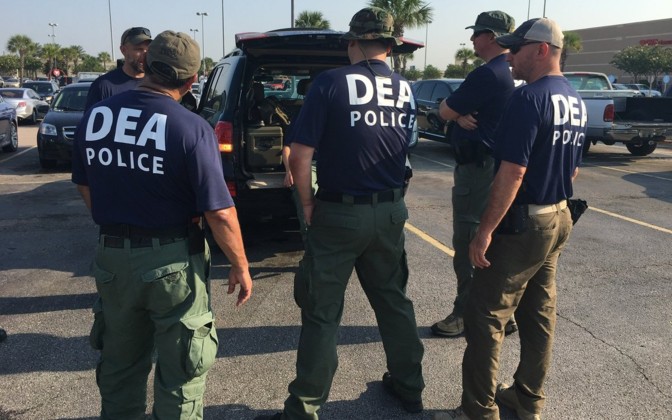DEA Keeping Supply of Rx Opioids Unchanged in 2025
/By Pat Anson
The Drug Enforcement Administration says it can’t do anything about shortages of opioid pain medication at U.S. pharmacies and will keep the 2025 opioid supply essentially unchanged from this year’s levels.
Under the Controlled Substances Act (CSA), the DEA sets annual aggregate production quotas (APQs) for every drug maker, in effect telling them the amount of opioids and other controlled substances they can make every year.
The APQs for 2025 were recently published in the Federal Register after a public comment period that received nearly 1,900 responses, many from patients and providers worried about further cuts in the opioid supply.
“DEA received a significant number of comments from pain advocacy groups, hospital associations, health professionals, and others who raised concerns over the proposed APQs for certain opioids in 2025,” DEA said. “After considering all of the relevant factors, DEA has determined… that U.S. manufacturers will need to manufacture approximately the same amount of those opioids in 2025 as in 2024 in order to meet legitimate needs.”
Although the FDA advised the DEA there will be a 6.6% decline in the medical need for opioids in 2025, the DEA adopted only minor reductions for several widely used opioid medications. They are the same amounts proposed by the agency in October.
DEA Opioid Production Quotas for 2025
Oxycodone: 0.137% decrease
Hydrocodone: 0.081% decrease
Morphine: Unchanged
Codeine: Unchanged
Hydromorphone: 0.015% decrease
Fentanyl: 0.0025% decrease
Although the reductions are tiny compared to previous years, 2025 will still be the ninth consecutive year that DEA has cut the supply of opioids. Since 2015, DEA has reduced production quotas for oxycodone by over 68% and hydrocodone by nearly 73%.
DEA acknowledged receiving many comments from pain patients who said their local pharmacies were often out of opioids, forcing them to contact additional pharmacies and travel further to get their prescriptions filled. DEA said those issues were out of its control.
“Drug shortages may occur due to factors outside of DEA's control such as manufacturing and quality problems, processing delays, supply chain disruptions, or discontinuations,” the agency said. “Currently, FDA has not issued notice of any nationwide shortages of the types of opioid medications mentioned by these commenters.”
The FDA and DEA may not be tracking opioid shortages, but the American Society of Health-System Pharmacists (ASHP) is.
Opioids currently listed in short supply by the ASHP include oxycodone/acetaminophen tablets, oxycodone immediate-release tablets, hydrocodone/acetaminophen tablets, hydromorphone tablets and solution, fentanyl solution, and morphine solution.
Most opioid medications are generic and cheap to make, but they have low profit margins and come with high risks. Teva Pharmaceuticals, a large generic drug maker, recently discontinued production of oxycodone and potent fentanyl lozenges. The medications were entangled in costly litigation that resulted in Teva paying $4.25 billion to settle opioid liability lawsuits.
Opioid shortages at the pharmacy level are also linked to litigation. Under the terms of a 2022 settlement with drug distributors, opioids are tightly rationed at many pharmacies, resulting in patients with opioid prescriptions being unable to get them filled because pharmacies are out of stock.
Here again, the DEA said the shortages are out of its control and claimed its prosecution of doctors for “unlawful” opioid prescribing was a non-issue.
“Patients and medical professionals may notice specific drug products are out of stock in particular areas; however, DEA cannot dictate DEA registrants' distributions of drug products,” the agency said.
“Additionally, DEA's regulations do not impose restrictions on the amount and the type of medication that licensed practitioners can prescribe. DEA has consistently emphasized and supported the authority of individual practitioners under the CSA to administer, dispense, and prescribe controlled substances for the legitimate treatment of pain within acceptable medical standards.”
Quotas Don’t Prevent Overdoses
For patients reliant on opioids, including those with late-stage cancer, being unable to fill a prescription means withdrawal, uncontrolled pain, and little quality of life.
A palliative care physician recently wrote an op/ed in STAT about “Teresa,” a patient in her mid-60’s with advanced cancer that spread to her abdomen.
“Only her prescription morphine gave her the relief she needed to function and enjoy some small pleasures, like walking her dog in the park,” wrote Dr. Rebecca Rodin, an assistant professor at the Icahn School of Medicine at Mount Sinai.
“But one day, her pharmacy didn’t have her morphine in stock, nor did five other neighborhood pharmacies that she went to. I called another three pharmacies before finding one with a two-week supply available — but it was a 40-minute drive from her home.”
Rodin says the real culprits in the overdose crisis are illicit fentanyl and other street drugs – not prescription opioids. And no amount of buck passing by the DEA will fix that problem.
“Quotas and resulting shortages of prescription pain medicines are not helping to prevent overdose deaths,” said Rodin. “Quotas are simply turning vulnerable patients with serious illness into collateral damage in a misguided effort to address the opioid epidemic.”














